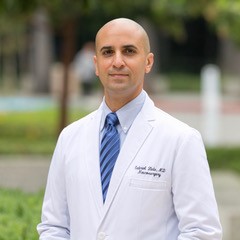
In two sessions focusing on pituitary tumors at next month’s CEU 2022, neurosurgeon Gabriel Zada, MD, MS, FAANS, FACS, will discuss advances in new surgical techniques and inpatient and long-term management, and give an in-depth overview of managing patients with pituitary adenomas. In addition, he will elucidate how health disparities can often have an even more devasting impact on those patients in underserved populations.
Gabriel Zada, a neurosurgeon and an internationally recognized expert in brain, skull base, and pituitary tumor surgery, knows all too well the importance of working closely with an endocrinologist when it comes to getting optimal outcomes for patients with pituitary tumors.
A patient once presented to his team with a challenging prolactinoma who was being treated with cabergoline, but her tumor wasn’t shrinking, so Zada thought surgery might be her next best bet. But Zada says after discussion with his colleague at USC Keck School of Medicine, John David Carmichael, MD, an endocrinologist who specializes in neuroendocrinology, they reviewed the case and Carmichael suggested trying the patient on a higher dose of medication before recommending an operation.
“And lo and behold, her tumor shrunk down, and she avoided surgery,” Zada says. “This was several years ago and not that I didn’t know it, but it really highlighted the importance of working with an endocrinologist to optimize everything and even avoiding surgery sometimes, can be done.”
Carmichael concurs regarding the necessity of a collaborative approach when treating patients with pituitary tumors. “The very nature of the medical issues inherent to pituitary disease makes an interdisciplinary approach toward diagnosis and ongoing management a necessity,” he says. “Working closely with Dr. Zada has been a huge part of our success as a center, as we have developed a clinic that capitalizes on the strength of a team approach.”
According to Carmichael, by making concurrent appointments between neurosurgery and endocrinology on the same day and at the same time makes communication much clearer between clinicians, treatment teams, as well as the patient and family members. “Plus, it makes the process fun for us!” he adds. “We really enjoy working together and that makes for an enjoyable experience for the patients and the rest of our team.”
Next month at the Endocrine Society’s Clinical Endocrinology Update 2022, attendees will have the chance to sit in on two sessions that take a closer look at operating on the pituitary gland, “Challenging Issues in Pituitary Neurosurgery” and “Perioperative Management of Pituitary Tumors,” both presented by Zada, MD, MS, FAANS, FACS, professor of Neurological Surgery, Otolaryngology, and Internal Medicine, and director of the USC Brain Tumor Center at the University of Southern California in Los Angeles. (Adriana Ioachimescu, MD, PhD, professor of Endocrinology and Neurosurgery at Emory University in Atlanta will join Zada for the latter session.)

“That’s why I love the pituitary so much, because so many things cross paths there, including your visual system and your endocrine system and even the hypothalamus is there. It’s so cool and it’s all in this little area.”
Gabriel Zada, MD, MS, FAANS, FACS, professor of neurological surgery, otolaryngology, and internal medicine; director, USC Brain Tumor Center; visiting associate, Caltech; USC Keck School of Medicine, University of Southern California, Los Angeles, California
Endocrine News caught up with Zada to take a look at both sessions, the challenges that surround pituitary neurosurgery – including health disparities – and how best to care for patients with pituitary tumors, from the time they agree to surgery until the time they are discharged and beyond.
Improving Techniques
Zada says that one of the ongoing issues neurosurgeons and endocrinologists face is just like the scenario he described above – making the best decision about when to operate. He points to patients with Rathke Cleft cysts, whether they should be operated on and how. Patients with prolactinomas are usually managed with medications, and Zada says that’s how it should be. “But we do get various scenarios that come up and as a surgeon, we have to work very closely with endocrinologists, which we do all the time, especially in tertiary care centers to make these decisions,” he says.
There are patients with Cushing’s disease and negative MRIs, and in those cases, Zada says he will talk about how to interpret data from various sources, including inferior petrosal sinus sampling, and he will go on to discuss how to better define the role of radiosurgery for Cushing’s. And in patients with Cushing’s and those with acromegaly, recurrent and invasive tumors continue to pose a challenge for surgeons.
But techniques have improved and risen to meet those challenges. Zada says he’ll talk about the role of endoscopy in pituitary surgery, and when to use more aggressive or extended approaches, when those are appropriate for various tumors, including pituitary tumors and craniopharyngiomas. He’ll also present on how to preserve the normal pituitary gland, what some strategies are, and any new technology that dovetails with those items. “An example is fluorescent tumor markers is something that’s on the horizon for brain and pituitary tumors that make the tumor glow, but not normal tissue, for instance, or maybe making the normal pituitary gland glow so we can preserve it. Various optical, fluorescent strategies, that’s a big one,” Zada says.
Health Disparities Up Front
And then there’s the systemic problem that seems to have its tentacles in everything: health disparities. Zada practices at a university and institution that has a private and a public hospital — same doctors and surgeons, but different patient populations. “We see the disparities right up front,” he says. “They exist; they’re real.”
Zada tells Endocrine News that those disparities revealed the more disadvantaged patients with pituitary tumors are usually diagnosed with more advanced tumors from the outset — larger, more invasive tumors, a more pronounced hormonal hypersecretion and acromegaly and Cushing’s disease, more invasive tumors, more pituitary apoplexy, which translates into hypopituitary and visual loss. “We find that that patient population presents in a completely different manner with more advanced disease,” he says. “And so that’s a mainstay. Then with all that, you can still provide fairly similar care for those patients if it’s the same physician team. But those disparities definitely exist.”
To best face these challenges, Zada says that pituitary surgery should be safe, especially at tertiary centers with high volume. A multimodal care team is often required for patients with more advanced pituitary tumors or functional pituitary tumors, Cushing’s disease, acromegaly, and prolactinomas. “It really requires a team approach with an endocrinologist, a neurosurgeon, a talented radiation oncologist, a neuropathologist who has good experience with these and can follow the WHO (World Health Organization) guidelines. An ophthalmologist,” he says. “Those are all really important pieces of a pituitary center to optimize care.”
The Endocrinologist’s Crucial Role
And once the providers and the patient decide that surgery is indeed the best course of action, Zada will discuss how to care for that patient at every step: preoperative lab tests carefully reviewed, thyroid and cortisol levels studied to make sure the patient doesn’t need replacement before anesthesia. For patients with Cushing’s or acromegaly, make sure their diabetes and blood pressure are well controlled.
Then, after surgery, Zada says that the next step depends on what type of tumor the patient has. He says he and his team check for diabetes insipidus in the first few days following the operation. “We do an AM cortisol level check in patients with no preoperative adrenal insufficiency, and we look for any evidence of new hypocortisolemia,” he says. “So that’s a really important thing in terms of perioperative management.”
Zada goes on to say that as patients transition to the outpatient scenario, they can regress, and about a quarter of patients will have hyponatremia, usually from syndrome of inappropriate antidiuretic hormone secretion. “And so,” he says, “one of the key pearls for perioperative management after surgery is to usually fluid restrict patients a little bit, and to minimize how much water they drink to avoid the development of symptomatic hyponatremia.”
“We do get various scenarios that come up and as a surgeon, we have to work very closely with endocrinologists, which we do all the time, especially in tertiary care centers to make these decisions.”
Gabriel Zada, MD, MS, FAANS, FACS, professor of neurological surgery, otolaryngology, and internal medicine; director, USC Brain Tumor Center; visiting associate, Caltech; USC Keck School of Medicine, University of Southern California, Los Angeles, California
Post-operation, lab testing gets specific, again depending on the type of tumor. For Cushing’s, Zada and his team will follow a cortisol level every six hours until the patient drops into remission. The care team wants to see a as low as possible of a cortisol level, usually around one or less. “And then for those patients, if they do bottom out and show a new low cortisol level, we will put them on hydrocortisone at a physiological dose, and then replace them, and then they’ll be able to go home,” Zada says.
“For patients with acromegaly, we get a growth hormone level the day after surgery, and that’s a good predictor of remission, but the delayed IGF-1 is really the important lab test to indicate remission,” he continues. “And for prolactinoma patients, which is rare, we will get a postop day one prolactin level to assess that.”
Beyond that, patients with Cushing’s are given deep vein thrombosis prophylaxis since they’re prone to blood clots. And Zada says he and his team like to ambulate patients every day, keeping them active and literally keeping their heads up after surgery.
And again, Zada recognizes how crucial an endocrinologist’s role is in every step of the way. After all, endocrinology is at the crossroads of just about every pathway in the body. “That’s why I love the pituitary so much,” he says, “because so many things cross paths there, including your visual system and your endocrine system and even the hypothalamus is there. It’s so cool and it’s all in this little area.”
Bagley is the senior editor of Endocrine News. In the June issue, he wrote about how obesity in men may have a bigger impact on osteoporosis than previously thought.

